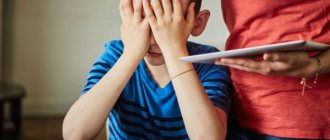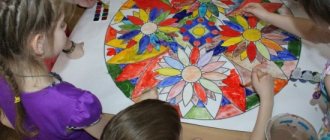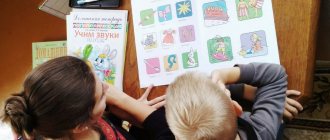Definition 1
Sensory education is ways of developing sensory perception of the surrounding world: determining the color, shape, size and other characteristics of objects that distinguish them from other objects.
Sensory education underlies the overall development of the younger generation. It is necessary for adequate knowledge of the structure of the surrounding world and its objects.
Sensory education of children with various speech developmental defects is especially important. This is due to the fact that speech disorders can be caused by deviations in the functioning of mental processes and brain function, and, consequently, deviations in sensory perception are observed. This leads to the need to build a special model of sensory education for children with speech defects.
Are you an expert in this subject area? We invite you to become the author of the Directory Working Conditions
Features of sensory development of a child with speech defects
Sensory development is important during the preschool years. It determines the effectiveness of preparing a preschooler for the next stage of his life - studying at school, since sensory development is responsible for the effectiveness of perception of the world around him.
Sensory development is realized throughout the preschool stage. At the same time, it has its own characteristics of development at different age periods.
As for children with speech defects, their sensory development differs in a number of specific features. These include:
- Reduced rate of perception of the surrounding world;
- Inaccurate perception due to malfunctions of visual and tactile perception caused by speech abnormalities;
- The study of objects in the surrounding world becomes lengthy and difficult. The study of objects is carried out on the basis of a number of practical actions, making a large number of mistakes;
- Untimely formation of standard ideas: difficulties in mastering shades of color, size parameters of objects: height, depth, length;
- A full-fledged image of an object, a holistic perception of its properties, is formed in the mind of a preschooler at a slow pace;
- Poorly developed ability to determine the properties of objects based on tactile perception: the child is practically unable to correctly form an idea of an object that he does not see;
- Difficulties in visual perception of objects in the surrounding world located in a non-standard environment;
- Spatial orientation problems that need to be quickly corrected.
Finished works on a similar topic
Course work Sensory education of children with speech disorders 450 ₽ Abstract Sensory education of children with speech disorders 240 ₽ Test paper Sensory education of children with speech disorders 240 ₽
Receive completed work or specialist advice on your educational project Find out the cost
The sensory development of a preschooler with various speech pathologies becomes uneven. It lags behind its normal development and is not activated during sensitive periods. This requires the organization of an education system focused on the sensory development of a preschooler in the presence of one or another speech defect.
Sensory development of preschoolers
Table of contents
Introduction…………………………………………………………………………………..3
Chapter 1. Theoretical foundations for studying the characteristics of sensory development of preschoolers without speech pathology………………………………………………………6
- Scientific and theoretical foundations of the study of sensory functions……..………………………………………………………………………………6
- Features of sensory development in preschool age………………………………………………………………10
Chapter 2. Features of sensory development of preschoolers with special needs…………19
- Characteristics of children with general speech underdevelopment……………19
- Features of sensory development of children with general speech underdevelopment………………………………………………………………………………………….28
Conclusion…………………………………………………………………………………31
Bibliography……………………………………………………………………………….33
Introduction
Sensory development is the development of perception and the formation of ideas about the external properties of objects: their shape, color, size, position in space; development of the ability to see, discover properties, relationships, dependencies in the surrounding world, the ability to “construct” them with objects, signs, words. It is early and preschool age that is most favorable for improving the activity of the senses and accumulating ideas about the world around us. The significance of sensory development is undeniable: cognition begins with the perception of objects and phenomena of the surrounding world; all other forms of cognition - memorization, thinking, imagination - are built on the basis of images of perception. Therefore, normal mental development of children is impossible without relying on a full perception of objects.
Sensory education, aimed at developing a full-fledged perception of the surrounding reality, serves as the basis for knowledge of the world, the first stage of which is sensory experience. The success of mental, physical, aesthetic education largely depends on the level of sensory development of children, i.e. depends on how perfectly the child hears, sees, and touches his surroundings.
At the stage of early childhood, familiarization with the properties of objects plays a decisive role. Professor N.M. Shchelovanov called early age the “golden time” of sensory education.
Many scientists have been involved in research in the field of sensory development of preschool children (B.G. Ananyev, M.E. Bernadskaya and I.V. Blinnikova, A.V. Zaporozhets, O.G. Solntseva and many others). In domestic pedagogy, the system of sensory education was developed by L.A. Wenger and N.B. Wenger, E.G. Pilyugina, A.P. Usova, etc. The development of this system is inextricably linked with the creation of the theory of perception in Russian psychology by B. Ananyev, L. Vygotsky, L. Wenger, A.N. Leontyev and others.
The relevance of this study is undoubted. Today, there is a need to study the sensory development of preschoolers due to the fact that, in recent years, as G.A. points out. Uruntaeva, the overwhelming number of children with speech disorders study in secondary schools and the number of such children is growing every year. Children with speech pathology, including general speech underdevelopment, as a rule, have difficulties in learning, since mental processes such as perception, imagination, and memory are formed and developed on the basis of speech and its semantic unit - words. L.S. has repeatedly pointed out the enormous importance of speech for sensory development and the development of thinking and personality formation. Vygotsky.
Thus, the problem of sensory development of children with speech pathology is becoming increasingly important.
The object of this study is the general underdevelopment of speech in preschool children.
The subject of this study is the features of the sensory development of preschool children with general speech underdevelopment.
The purpose of this course work is to study the characteristics of the sensory development of preschool children with general speech underdevelopment.
Taking into account the object, subject and goal, a number of specific tasks were set:
- Study psychological-pedagogical, speech therapy, linguistic, psycholinguistic and methodological literature on the research problem.
- Expand the concept of sensory development of preschool children.
- To study the features of sensory development of preschool children with general speech underdevelopment.
Achieving goals and completing tasks is possible thanks to the following work methods:
— study of theoretical and methodological literature on the research topic;
- analysis;
- comparison.
The work consists of an introduction, two chapters, a conclusion and a bibliography.
The introduction indicates the goals, main objectives, and research methods.
The first chapter reveals the scientific and theoretical foundations of the study of sensory functions, as well as general concepts of sensory development of preschool children based on the works of domestic and foreign teachers.
The second chapter provides characteristics of children with general speech underdevelopment, and also examines the features of the sensory development of children with general speech underdevelopment based on an analysis of domestic and foreign literature on the research problem.
In conclusion, based on the study and analysis of psychological-pedagogical, speech therapy, linguistic, psycholinguistic and methodological literature, the main conclusions are formulated.
The bibliography includes psychological-pedagogical, speech therapy, linguistic, psycholinguistic and methodological literature.
Chapter 1. Theoretical foundations for studying the characteristics of sensory development of preschool children without speech pathology and children with general speech underdevelopment
- Scientific and theoretical basis for the study of sensory functions
Each person communicates with the world around him, perceives and studies it with the help of five senses or sensory systems: vision, hearing, touch, smell and taste [1, p.15]. For the overall development of a child, sensory development and the formation of ideas about the external properties of objects: their shape, color, size, position in space, as well as smell, taste, etc. are of great importance. These sensations develop and are formed naturally, but the more diverse information a child receives, the more active the process of formation of nerve cells (neurons) occurs, and this cannot but affect the level of his intelligence.
The content and methods of sensory education are based on a number of important provisions about the essence of perception and its development in children [19, p. 57]:
1) sensations and perceptions are considered not as receptor processes, but as reflex ones. This means that sensation and perception are not a passive mirror reflection of individual qualities of an object or an object as a whole, but are considered as special actions of analyzers aimed at examining the object and its features. The development of perception itself is considered as a long-term path for a child to master sensory actions;
2) the development of perception in a child is considered as a process of assimilation of social sensory experience, as the formation, under the influence of adults, of new, previously non-existent sensory abilities. First of all, the child masters the system of perceptual (examination) actions, established by humanity as methods that ensure adequate knowledge of the environment, then masters the system of standards and learns to use them as measures of quality for his sensory experience (a system of geometric shapes, colors, sizes, materials, sounds in height; norms of pronunciation in speech; system of directions, etc.).
3) the development of perception occurs in the process of meaningful activity: in the first year of life it is associated with the child’s objective activity, and later – with more complex types of activity: visual, constructive, play, labor, educational. The sensory development of a child and the development of various types of his activities are closely interconnected and interdependent.
Among all cognitive processes, sensation and perception take the place of the primary source of information in the holistic process of cognition: on the basis of sensations, perception develops, then memory, speech, and perception is the foundation for thinking. This is especially evident in the preschool period, when sensory processes are leading in the child’s acquaintance with the world.
Types of perception are determined by the nature of the perceived properties, objects and phenomena of reality. The child begins to master each type of perception at a certain age, based on previous experience.
The following types of perception are distinguished:
- perception of shape is the first type of perception available to a child in infancy up to 1 year; he learns to distinguish objects, first of all, by shape;
- color perception;
— perception of size is the most difficult property to master, since each time the standard is a different object;
- perception of space - is formed on the basis of experience through the movement of the body, limbs, head, eyes, to which are added visual images of objects changing during movement, their proportions, position; is formed as the motor sphere and speech develop (spatial concepts are fixed in words);
- perception of time - formed on the basis of experience gained through actions, emotional experiences of ongoing life events, external signs of changes in the environment and objects; the totality of these features is fixed in the following concepts: the names of the time of day, time of year, units of time, the passage of time (fast, long, often, rarely, yesterday, today, tomorrow);
- perception of body movements - consists of sensations of body posture, limbs, movements and is consolidated into a holistic dynamic image;
- perception of the special properties of objects and phenomena - the combination of sensations from different senses: visual, gustatory, olfactory, tactile and motor, auditory, which give a more correct and versatile idea of any object or phenomenon;
— perception of integral objects is the main task of perception, which is carried out thanks to the complex integration of information from all types of perception [24, p. 77].
According to D.B. Elkonin, the development of reference values of qualities and properties takes place in three periods:
- the first period - from birth to three years - the period of sensorimotor pre-standards, when the child displays only individual features of objects that are essential for direct motor adaptation - shape, size of objects, distance, etc.;
- second period - from three to five years - the child uses subject standards, i.e. patterns of object properties are correlated with certain objects, for example, an oval is determined through the shape of a cucumber;
- the third period - over five years - based on the accumulation of experience and its generalization under the guidance of an adult, children master generally accepted standards, when the properties of objects themselves acquire a standard value in isolation from a specific object (green grass, apples like a ball, the roof of a house is triangular, a wooden pencil ) [25, p.253].
This mastery of socially developed standards and mastery of perceptual actions changes the nature of perception: the child gains the opportunity for independent generalized knowledge of the environment, the formation of dissected and complete ideas;
Uruntaeva G.A. distinguishes three periods of sensorimotor development.
She considers infancy to be the first period of sensorimotor development, when the higher analyzers - vision, hearing - are ahead of the development of the hand, as an organ of touch and an organ of movement, which ensures the formation of all the basic forms of child behavior, and therefore determines the leading role in this process.
By the second period of sensorimotor development G.A. Uruntaeva refers to early childhood and notes that perception and visual-motor actions during this period remain very imperfect.
The third period G.A. Uruntaeva considers the preschool age when sensory development is based on special cognitive activity, which has its own goals, objectives, means and methods of implementation. Game manipulation is replaced by actual investigative actions with the object and turns into purposeful testing of it to understand the purpose of its parts, their mobility and connection with each other [21, p. 153].
By older preschool age, as noted by I.V. Nosko, the examination takes on the character of experimentation, investigative actions, the sequence of which is determined not by the child’s external impressions, but by the task assigned to him, the nature of the tentative research activity changes. From external practical manipulations with an object, children move on to familiarization with the object based on vision and touch. The most important distinctive feature of the perception of children aged 5–7 years is the fact that, combining the experience of other types of orientation activities, visual perception becomes one of the leading ones [20, p.62].
- Features of sensory development in preschool age
Model of sensory education for preschoolers with speech defects
Sensory education of children with various speech pathologies is implemented on the basis of a special program, including corrective measures to eliminate or smooth out speech disorders and enhance sensory perception.
The period of sensory learning for a child with speech disorders is longer and more labor-intensive. Children make many mistakes when naming the characteristics of objects. They cannot easily transfer the sensory patterns they have learned to real objects. This requires long-term practice and a large number of training exercises.
The model of sensory education for preschoolers with speech disorders can be presented as a process of cognition by a preschooler of the properties of objects through their perception in motion. This means that the motor analyzer is activated for perception. The process of perception becomes a real action implemented by the child to understand the properties of the object.
The perception of objects occurs in several stages:
- Conducting a visual inspection of the object: the child traces the outline of the object with his eyes.
- Having outlined the object visually, the child compares it with the forms that he knows and assigns this object to one of the forms.
- Dividing an object into parts and visual inspection, outlining the contours of each part.
- Determining the spatial location of each part of an object in relation to its underlying detail: located “above”, “to the left”, “to the right”, “to the side”, etc.
- Familiarity with the color scheme of an object and its parts. The child names the color of the entire object and each of its parts. If there is a predominant color, then it is worth noting, and also identifying all the colors and shades that the object has.
- Determination of the spatial orientation of the object in question.
This model is focused on the development of sensory perception in children with well-developed visual perception. If there are deviations in this area, then the contours of objects should be outlined using tactile perception.
Note 1
All classes are conducted in a playful way and include speech therapy correction of an existing speech defect.
Sensory impairment in children
General information
The sensory system is part of the nervous system and is responsible for perception. It consists of receptors, nerves and parts of the brain responsible for processing received signals. Sensory systems (analyzers)—motor, vestibular, auditory, visual, tactile—inform the child’s central nervous system about the characteristics of movement and create a comprehensive understanding of body position.
Sensory impairment in children
With cerebral palsy (especially in the hyperkinetic form), hearing acuity quite often decreases (usually noted for high-frequency tones). This may contribute to impaired pronunciation of a number of sounds in the absence of dysarthria. A child who does not hear high-frequency sounds (t, k, s, p, e, f, sh) does not use them in his speech production. Subsequently, difficulties are noted in teaching such children to read and write. Some patients have underdeveloped phonemic hearing. Any impairment of auditory perception can lead to delayed speech development, and in severe cases, to severe speech underdevelopment. Children with intellectual disabilities may also have other physical and developmental disabilities that can profoundly affect their mental and physical health. Such deviations are usually associated with the degree of intellectual impairment. If a child experiences a sensory disorder, it is necessary to seek help from a neurologist or psychologist.
Causes of sensory impairment
Sensory impairment in children is associated with a disorder in the part of nervous system responsible for perception. Sensory impairments include:
- hearing;
- vision;
- musculoskeletal function.
The causes of sensory disorders can be various injuries (for example, head or back), infectious and viral diseases of both the child and the mother during pregnancy (rubella, cytomegalovirus), sexually transmitted diseases of parents, pathological conditions of pregnancy and childbirth. Very often, sensory disturbances are observed in premature babies.
Sensory disorders are characterized by: the child’s lack of reaction to sound, light, speech impairment, and the inability to perform voluntary movements. Children suffering from sensory impairments often try to attract attention to themselves through movements; during a conversation, they carefully look at the movements of the interlocutor’s lips, their speech is difficult, and some sounds are pronounced incorrectly. If the central nervous system disorders are serious, then the child cannot move without assistance (with cerebral palsy, paralysis and paresis).
Treatment of sensory disorders in children
To correct sensory regulation, there are sets of special exercises that are aimed at improving integration between the channels of the sensory system. One of the most effective methods is the “sensory diet”. It consists of rubbing the child’s body every 2-3 hours with special brushes.
The method of changing sensitivity thresholds is to gradually accustom the child to the stimulus of touch through daily exercises. Experts often recommend this particular correction method to parents. Also very useful:
- rubbing the body with a sponge (for example, while bathing);
- body massage;
- crawling under the blanket;
- dragging the blanket on which the child across the floor;
- baby pushing heavy objects (large sofa ottomans, doll strollers or highchairs loaded with books for weight);
- tug of war;
- climbing exercise walls in the park or gym;
- jumping on the sofa or trampoline;
- pillow fight;
- walking on hands (legs supported by an adult);
- climbing stairs on all fours;
- imitation of special movements and jumps of different animals.
In addition, you can use exercises such as somersaults (with belay), jumping rope, exercises.
Working with plastic materials (dough, plasticine, clay, plaster), as well as playing with sand, perfectly develops motor skills. Accustom your child to work around the house (wiping dust, washing dishes, watering flowers and other care for indoor plants) or in the garden (planting plants and trees, caring for them, germinating seeds). Caring for animals, playing and interacting with them is another great way to develop sensory skills.
Sensory standards
According to recent research, sensation and perception are special actions of the analyzer aimed at studying an object and its properties. To develop a child’s analyzers means to teach him actions to examine an object, which in psychology are called perceptual actions. Through acts of perception, the child perceives new qualities and properties of an object: by stroking, he learns about the surface (smooth, rough); by pressing, determines hardness (softness, elasticity), etc. The task of sensory education is to teach the child these actions in a timely manner. Generalized ways of looking at objects are important for the formation of comparative operations, generalization, and for the development of thought processes.
Sensory standards are generalized sensory knowledge, sensory experience accumulated by humanity during the history of its development. The external qualities and properties of objects in the surrounding world are extremely diverse. In the course of historical practice, systems of those sensory qualities that were most important for a particular activity were developed: Systems for measuring weight, length, direction, geometric shapes, color, size; norms of phonetic pronunciation, system of tones in pitch, etc. Each sensory standard has its own verbal designations: measures of weight, measures of length, color spectrum, arrangement of notes on a staff, planar and volumetric geometric shapes, etc.
Learning sensory standards is a long and complex process, the main burden of which falls on the school years. Does a preschool child need sensory standards? A.V. Zaporozhets believes that a set of measures and standards must be given in preschool age. Since children have these standards, they will refer to them any perceived quality, giving it a definition. Thanks to these “units of measurement,” the child more fully and deeply learns the various qualities of certain objects, his perception becomes focused and organized.
In the first years of life, children develop the prerequisites for sensory norms. From the second half of the first year to the beginning of the third year, the so-called sensorimotor prematrices are formed. During this period, the baby exhibits the individual characteristics of objects that are necessary for his movements (certain features of the shape, size of objects, distance, etc.).
In preschool age, the child uses so-called object standards: he correlates images of the properties of objects with certain objects (he calls the color orange “like a carrot”; he identifies a square by the shape of a bag or scarf). Usually this period lasts until the turn between the fifth and sixth years of life, but it can drag on if adults “implant” subject standards into the child’s activities. Meanwhile, studies have shown that children of senior preschool age can correlate the properties of objects with mastered general standards: the sun in the form of a ball, a lemon, an oval cucumber. For a child of this age, the seven colors of the spectrum and their shades serve as color standards, the system of geometric figures as shape standards, the “grid of phonemes” of the native language, the tonal scale of musical sounds (do, re, mi, fa, sol, la, si) and others - standards of auditory perception. According to M. Montessori's system, children's feelings and perceptions developed with the help of special materials in the classroom. The home system of sensory education is based on the recognition of the need to develop children's perception in the process of meaningful activity, which is organized not only in the classroom, but also in everyday life. For example, when should children be introduced to the properties of water? Is it really necessary to do this for this particular class? Of course not! While washing, playing with water in a group room, in a room where the teacher teaches pupils review activities that help them study the properties of water (transparent, odorless, tasteless, its shape, fluid, changes in temperature, freezes in the cold, various objects float and sink on it, etc.).
In the first year of a child’s life, the tasks of sensory education (development of hearing, vision, formation of objective perception) are successfully solved in manipulative and objective-practical activities. In the future, the richest opportunities for sensory development are hidden in activities such as play, work, construction, and graphics.







